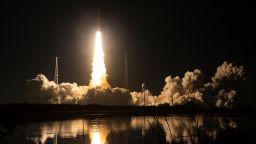Sign up for CNN’s Wonder Theory science newsletter. Explore the universe with news on fascinating discoveries, scientific advancements and more.
Senior NASA officials say that the agency’s Space Launch System — the massive rocket designed to propel its ambitious Artemis program to establish a base on the moon — is “unaffordable,” according to a report Thursday from the US Government Accountability Office.
The report, which breaks down SLS program expenditures, makes the striking admission that senior NASA officials deem the rocket to be unsustainable “at current cost levels,” and it criticizes what the GAO said is a lack of transparency into the program’s ongoing costs. The report does not name which officials — or how many — at NASA made such claims.
A spokesperson at NASA’s headquarters did not immediately respond to a request for comment.
However, the GAO report does state that NASA “recognizes the need to improve the affordability.”
“With input from NASA management, the SLS program has developed a roadmap outlining short-term and long-term strategies that it hopes will result in future cost savings,” the report said.
That plan includes efforts to “stabilize the flight schedule,” increase efficiencies, “encourage innovation” and “adjust acquisition strategies to reduce cost risk,” according to GAO.
The SLS rocket is at the core of NASA’s Artemis program, the agency’s flagship effort to return humans to the surface of the moon later this decade that also involves various exploratory and science missions aimed at establishing a permanent lunar settlement.
The first test launch of SLS, in a mission dubbed Artemis I, took off November 16 after years of delays. The mission, though behind schedule, was regarded as a spectacular success, setting NASA up to launch its first crewed test mission around the moon in late 2024. That’s expected to be followed by Artemis III, the first attempt to return American astronauts to the moon since the Apollo program.
But the Artemis I success has not insulated NASA from the program’s critics.
Government watchdogs, including the GAO and NASA’s inspector general, have repeatedly blasted the space agency’s SLS program in reports dating back to 2014, as the GAO spelled out in its latest documents. The GAO is an investigative branch of the US government charged with overseeing public spending.
Much of the criticism levied by those watchdogs has focused on contracting issues, such as cost overruns with the SLS program’s primary contractors. The watchdogs have also reported transparency issues, saying NASA has not given all-in cost estimates for scheduled Artemis launches or done enough to attempt to break down ongoing expenses for the program.
The GAO report also noted that it had suggested to NASA in 2014 that the agency should “develop a cost baseline that captures production costs” for missions using SLS Block I — or the first version of the rocket that is expected to pave the way for larger, more powerful versions in the development pipeline. But while NASA “partially concurred,” the agency “has not yet implemented this recommendation,” the GAO report said.
The report found that the space agency “does not plan to measure production costs to monitor the affordability of its most powerful rocket.”
In addition to the nearly $12 billion already spent developing the SLS rocket, NASA asked for more than $11 billion in its most recent budget request to fund the program for the next four years, according to the report.








